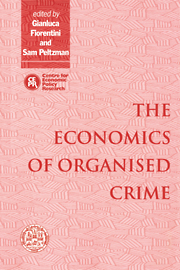Book contents
- Frontmatter
- Contents
- List of figures
- List of tables
- Foreword
- Acknowledgements
- List of conference participants
- 1 Introduction
- PART I THEORIES OF THE STATE AND THE ORIGIN OF CRIMINAL ORGANISATIONS
- PART II THE CRIMINAL ORGANISATION AS A FIRM
- 4 Internal cohesion and competition among criminal organisations
- Discussion
- 5 Conspiracy among the many: the mafia in legitimate industries
- Discussion
- PART III ORGANISED CRIME AND STATE INTERVENTION IN THE ECONOMY
- PART IV DETERRENCE POLICIES AGAINST LEGAL FIRMS INVOLVED IN ILLEGAL ACTIVITIES
- PART V DETERRENCE POLICIES AGAINST ORGANISED CRIME
- Index
Discussion
Published online by Cambridge University Press: 04 August 2010
- Frontmatter
- Contents
- List of figures
- List of tables
- Foreword
- Acknowledgements
- List of conference participants
- 1 Introduction
- PART I THEORIES OF THE STATE AND THE ORIGIN OF CRIMINAL ORGANISATIONS
- PART II THE CRIMINAL ORGANISATION AS A FIRM
- 4 Internal cohesion and competition among criminal organisations
- Discussion
- 5 Conspiracy among the many: the mafia in legitimate industries
- Discussion
- PART III ORGANISED CRIME AND STATE INTERVENTION IN THE ECONOMY
- PART IV DETERRENCE POLICIES AGAINST LEGAL FIRMS INVOLVED IN ILLEGAL ACTIVITIES
- PART V DETERRENCE POLICIES AGAINST ORGANISED CRIME
- Index
Summary
Gambetta and Reuter's timely study addresses the neglected problem of the mafia's role in legitimate activities in a new and intriguing way: their idea is that ‘mafia solves a problem of potential cartels’, by providing a paid service to entrepreneurs asking for ‘profit-enhancing and riskreducing regulation’. In their conclusion they seem to downplay the argument proposed, arguing that in recent years the mafia has been losing power and therefore that their analysis may be of ‘more analytical than policy interest’. We think instead that it is too early to be optimistic: the problems raised by Gambetta and Reuter remain important because the mafia is an overlooked danger for the process of European unification and it could prove to be a major obstacle to the wellfunctioning of its market.
Their analysis offers some novel insights, together with some difficulties which we now consider in more detail. Put into economic terms their model implies a market for a peculiar service, namely the ‘punishment’ needed for implementing a stable cartel agreement: equilibrium in the market results from a legal demand curve, made up by the firms willing to form a cartel, and the illegal supply curve, provided by the mafia.
The alternative to this framework would be to consider the mafia as an exogenous ‘auctioneer’, but that would simply assume what has rather to be explained, namely the mafia's economic role. The nature of this market is intrinsically multi-periodic and changing over time: before selling this service the mafia is (by definition) a monopolist facing a downward demand curve.
- Type
- Chapter
- Information
- The Economics of Organised Crime , pp. 136 - 140Publisher: Cambridge University PressPrint publication year: 1996



